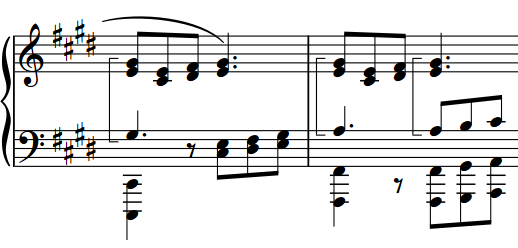Lines
Lines can convey a variety of meanings in music, such as indicating which hand to use in piano music or a gradual change in bow pressure. In Dorico Pro, lines can be vertical, horizontal, or angled between notes and have different styles and appearances.

Due to their generic designs, such as a dashed line with arrow end cap, lines in Dorico Pro have no definitive musical meaning and function primarily graphically, meaning they do not affect playback. Dorico Pro includes dedicated features for specific notations that affect playback if applicable, such as dynamics, arpeggios, glissandi, and trills.
The following types of lines are available in Dorico Pro:
- Horizontal lines
-
Horizontal lines span a specified duration, that is, they start at one rhythmic position and end at a later rhythmic position. They might indicate a change over time, such as a wedge that represents bow pressure, or suggest a link between notes, such as a bracket spanning the theme in a fugue or a straight line between notes showing where a melody moves to a different staff.
Attachment types control the positions of horizontal lines and certain aspects of their functionality. Horizontal lines can have different attachment types at their start and end.
NoteYou cannot change the attachment type of horizontal lines after they have been input.
In Dorico Pro, each end of horizontal lines can have the following attachment types:
-
Notehead-attached
Attached to an individual note independently of its rhythmic position, meaning that the ends of notehead-attached lines move with notes if you change their pitch or move them rhythmically. Notehead-attached lines can be both angled or horizontal, as their end positions and resulting angles are determined by the interval between the start and end notes.

Figure 2. A phrase containing two notehead-attached lines, showing where the melody moves between piano staves -
Barline-attached
Attached to a rhythmic position and aligned with barlines, if their rhythmic positions coincide with barline positions. Barline-attached lines are always horizontal.

Figure 3. A barline-attached line spanning two full bars -
Rhythmic position-attached
Attached to a rhythmic position and positioned relative to notes, chords, or rests at those rhythmic positions.
Rhythmic position-attached lines are horizontal and placed above the staff by default. Their endpoints start to the left and end to the right of notes, chords, or rests at the corresponding rhythmic positions.

Figure 4. A rhythmic position-attached line spanning two full bars
-
- Vertical lines
-
Vertical lines exist at a single rhythmic position and are positioned relative to notes, chords or rests at that position. They might convey details about a specific moment, such as indicating which hand to use for specific notes in piano music.

Figure 5. Vertical lines indicating which notes to play with the right hand